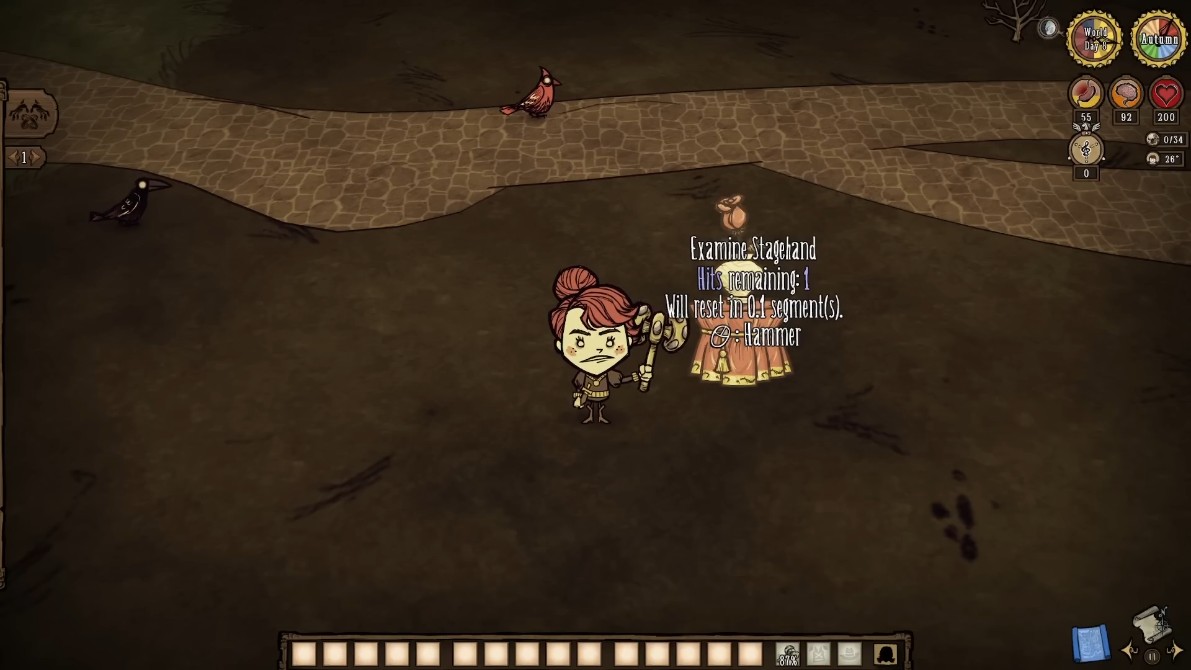What Even Is a Stagehand? (And Why It’ll Ruin Your Day)
Stagehands are one of those Don’t Starve quirks that seem harmless until they’re actively trying to murder you. Picture this: you’re wandering through a cobblestone path, minding your own business, when you spot a decorative table surrounded by roses. “Cute,” you think. Then night falls, and that table transforms into a spider-legged nightmare that creeps toward your campfire like a horror movie villain.
These structures are tied to Charlie, the game’s shadow queen, and serve two purposes:
1. Cosmetic traps: By day, they’re inert set pieces. By night, they become light-obsessed monsters.
2. Blueprint farms: Hammering them 86 times (yes, eighty-six) drops End Table blueprints.
But here’s the kicker: most players discover Stagehands after they’ve already triggered a chain reaction of chaos. Let’s break down why they’re equal parts fascinating and infuriating.
5 Mistakes Everyone Makes with Stagehands (and How to Avoid Them)
1. Attacking It “Just to See What Happens”
The scenario: You’re new to the game. The Stagehand looks destructible. You swing your axe.
The outcome: It retaliates with 60 damage per hit, which is roughly 40% of Wilson’s health.
Why this sucks:
- Stagehands regenerate health instantly.
- They aggro nearby enemies, turning a curiosity check into a boss fight.
What to do instead:
- Use a Hammer from a distance.
- Keep healing items ready (e.g., Honey Poultice).
2. Ignoring the Nighttime Behavior
Stagehands activate only in darkness and gravitate toward light sources like moths to a flame. I once lost a 100-day base because a Stagehand crawled into my campfire during a hound attack, extinguishing it mid-winter.
Pro tip:
- Place End Tables (crafted from Stagehand blueprints) as decoy light sources.
- Use Night Lights instead of campfires near Stagehand spawns.
3. Underestimating the Prickly Stagehand
Prickly Stagehands, introduced in the Little Drama update, are a whole new tier of pain:
- Damage: 80 per hit.
- Mechanics: Spawn in pairs near the Stage set piece and attack if you perform plays incorrectly.
| Normal Stagehand | Prickly Stagehand |
|---|---|
| 60 damage per hit | 80 damage per hit |
| Passive unless provoked | Aggressive during performances |
| Drops End Table blueprints | Drops nothing (pure menace) |
4. Hammering Without a Plan
Getting the End Table blueprint requires hammering a Stagehand 86 times without stopping. Miss the timing? Start over.
A real-world analogy: It’s like trying to beat a Dark Souls boss with a DDR pad—possible, but needlessly punishing.
Strategy:
1. Build a Stone Wall enclosure around the Stagehand.
2. Use a Weather Pain to automate hammering (yes, this works).

End Tables serve multiple purposes, including as a light source and a barrier.
5. Using End Tables Wrong
End Tables aren’t just decor. They’re Swiss Army knives for base defense:
- Light source: Hold Light Bulbs or Glowberries for 10 days.
- Boss barriers: Their collision blocks giants like Deerclops.
lua
-- Example: Automating End Table light
local function RefillLight(inst)
if inst.components.fueled:GetPercent() < 0.2 then
inst.components.fueled:SetPercent(1)
end
end
When Stagehands Become Your Secret Weapon
Case Study: The 300-Day Base That Outsmarted Charlie
A Reddit player ("ShadowWalker_87") shared how they exploited Stagehand mechanics:
1. Lured a Stagehand into a Moonstone field.
2. Used its light attraction to trigger Moonstorm events early.
3. Farmed Infused Moon Shards without fighting bosses.
Key takeaway: Stagehands can manipulate environmental triggers if positioned strategically.
The “Stagehand Express” Tactic
Need to move resources across biomes?
1. Place End Tables in a path.
2. Let Stagehands follow the light chain.
3. Use their collision to herd beefalo.
Final Thoughts: Embrace the Chaos
Stagehands embody Don’t Starve’s design philosophy: cruel, unpredictable, but deeply rewarding if you adapt. Next time you see one, ask yourself:
- Is this a threat or an opportunity?
- Do I have enough healing items to gamble?
Actionable summary:
1. Never engage without walls/healing.
2. Use End Tables for light and defense.
3. Hammer with purpose (or automation).
Further resources:
- Stagehand Wiki
- Advanced Hammering Guide
Now go forth—and may your next Stagehand encounter be less… fatal.